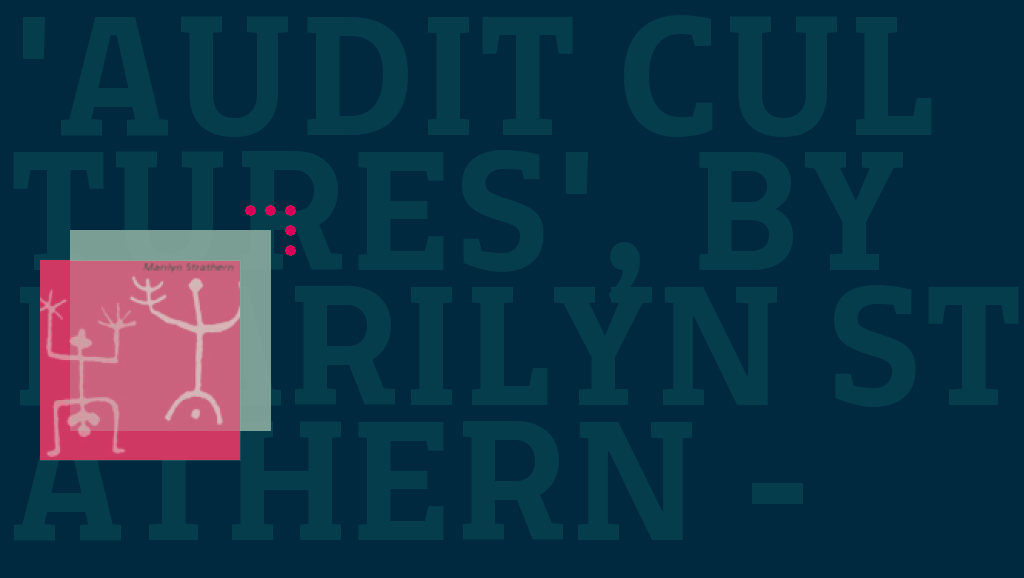In her edited collection Audit Cultures published in 2000 by Routledge, one of the leading figures of British anthropology, Marilyn Strathern, sets out to chart a new “kind of culture on the make”, in one word a socially, morally and politically pervasive form of innovation, that of “new accountabilities”. It is of interest for us to revisit this ground breaking text in anthropology because of its explicit concern, on the one side, with moral reasoning, ethics and the credibility of enterprises; on the other, with the emergence of a global set of practices “confined to no single institutions”, which are rooted in financial accounting and prescribe economic efficiency in terms of “good practice” – the practices of auditing.
The fact that the collection of essays tends to concentrate on the social impact of auditing in the academic practice is of less interest to the reviewer, than its clear and open focus on the facts that
1. auditing is a procedure of assessment that as such results from, and results in, social situations, despite its aura of absoluteness, transparency, and neutrality. In other words, auditing creates performances that are unique to contexts, personalities and relationships and can be investigated ethnographically, i.e. through a genetic, or historical, logic of narrative and involvement (as shows Richard Harper in his ethnography of the International Monetary Fund in chapter 1 -a case study of how IMF officers on a mission need to liaise with local authorities, and in particular between different levels of the local authorities, as well as amongst themselves, in order to “build up” a meaningful picture form the macroeconomics data gathered in situ. In particular, meetings need both negotiations and ritualisation in order to transform them into “meetings that count” and produce consensual policy frameworks).
2. because of the ways in which they are implemented and engrained in the texture of local and everyday practices, though, audit cultures become “rituals of verification” that, as such, are “almost impossible to criticize in principle”.
3. nevertheless, cultures of accountability are, after all, cultural and this tends to emerge particularly in those bodies of government such as the EU Commission, which incorporate not only diverse languages and traditions of civic professionalism but also, as a result, different concepts and practices of governance (as shown by Maryon McDonald in chapter 4).
Because of this double focus on context and on ethical systems of reference, then, the new accountabilities that are criticised as ultimately endangering freedom of research in the academy are of much larger interest to society as a whole – in that they pervade both private corporations and public governments by implicating individuals in “self-checking practices”. One example for all is the ubiquity and proliferation of quality control checks (see chapter 3 by Eleanor Rimoldi), from the production contexts characterised by a high degree of automation to those of apprenticeship, individual learning and tacit knowledge, with at times despairing effects. As Rimoldi shows comparatively in the case of universities and professional training in New Zealand (spanning from training in critical theory to one in beauty therapy), protocols for control checks tend to become “the measure of all things”, with grave implications for the ways in which they actually mould professional and training practices (for instance, by transforming them from a seamless experience of skill to one of digesting “units of learning” and separate competences).
What is of most interest in this book, beyond the denunciation of the plight of academy, is the anthropological approach adopted in order to “think of audit as an actant” in Bruno Latour’s sense – that is an object (in this case a practice) which is endowed with power and agency of its own. This ethnographic approach is original and could be of use to the study of political institutions, economic organizations and in management studies, providing “a network of descriptions pertaining to audit, ethics and policy”.

From rock engravings in Val Camonica, Northern Italy, c. 800-200 BC.
Cover Design: Sutchinda Rangsi Thompson
In Amazon.com: Table of Contents; Excerpt; Index and Back Cover
















